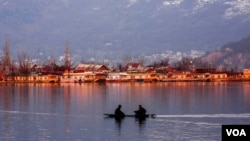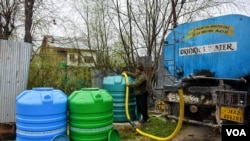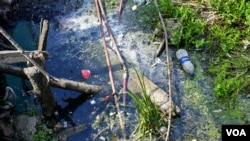Rosy, who goes by her nickname, was 26 when she was married in Gudoo, a locality within one of the 50 hamlets or small villages bordering Dal Lake in the Indian-administered Jammu and Kashmir's Srinagar city.
Deemed the "jewel" of Kashmir by the state government, the urban freshwater lake in the Himalayan region attracts tens of thousands of tourists every year from around the globe. It has been for decades the source of water, livelihood and food for the 50,000 locals who reside nearby.
But for those living in the Dal Lake hamlets, clean water is a luxury, waterborne diseases are common and brides for men of marriageable age are elusive.
In 2017, a Right to Information request — an Indian constitutional right that allows citizens to request information under the control of a public authority — found that about 11 million gallons (41.6 million liters) of sewage was released into the lake from the city every day.
Rosy, now 29, told VOA that she "regrets" moving to the Dal Lake area.
"I keep going back to my parents' house in a different area of Srinagar because there I can use as much water as I like for washing clothes and cooking. You won't believe it — I can only take a bath once a week. When I need to wash clothes, I have to pick a day and visit my acquaintances in a separate area to use their water. It is torturous living here," she said.
Farooque Ahmad, 55, who lives near Dal Lake, told VOA that in the past few months, three girls have rejected his son's marriage proposal after initially accepting it.
"Whenever a girl's family finds out that we have no water here, they reject the marriage proposal immediately. In fact, even matchmakers have stopped bringing any matches for boys here," he said.
"Many feel that their daughters, if married here, will have to carry gallons of water to their houses every day. Who would want their child to marry in an area like this, especially in an age where most people have every facility reaching their doorstep in the blink of an eye?"
Water resources and environmental experts say that the water crisis in Kashmir's Dal Lake region is largely caused by human activity.
Kashmir-based Shakil A. Romshoo, vice chancellor at Islamic University of Science and Technology, told VOA that contrary to popular misconceptions, Kashmir's water supply has not been affected by climate change.
"Kashmir is sitting atop the water tower of Asia [the Himalayan region]. With almost 18,000 glaciers nourishing the water supply in the state, the problem is not the quantity of water but the quality of it.
"Around 80% of Srinagar gets its water supply from the Dal Lake. Yet, untreated wastewater from several sources — households, hotels on the periphery of the lake and toilets in the houseboats on the lake — goes directly into the lake untreated. This makes the water undrinkable due to the high chloroform count," said Romshoo, a researcher specializing in glaciology and climate change.
A Jammu and Kashmir High Court-appointed committee of experts (CoE), formed two years ago, stated in its latest report that about 70% of the sewage generated in Srinagar city finds its way into Dal Lake.
The three sewage treatment plants — which are supposed to treat the wastewater making it safe for disposal before it goes into the lake — were called "heavily over-utilized," "under-maintained" and "far below" the standards set by the Pollution Control Board of India.
Bashir Ahmad Bhat, vice chairman of the state's Lake Conservation and Management Authority (LCMA), which is the sole authority responsible for "managing and conserving" Dal Lake, among other water bodies in Kashmir, said that the claims made by the CoE are "factually incorrect."
"No sewage from catchments goes directly into the Dal. ... There are systems in place to treat the remaining waste coming in from houseboats, of which 90% have already been connected to the system. The sewage from hamlets is taken up under the prime minister's development package.
"All the five steps of treating 36 million liters [of wastewater] per day are done under the vigilance of an online monitoring system, all of which conform to the norms of the Pollution Control Committees," he told VOA.
Climate activist and columnist Raja Muzaffar Bhat said that the water pollution problem in Kashmir is not limited to Dal Lake.
"The entirety of the Srinagar city's liquid waste goes untreated into the Dal Lake, Jhelum and Doodh Ganga rivers, and other water bodies through drainage systems," he told VOA.
Mushtaq Ahmad, president of the Gudoo locality where Rosy lives, said that more than 13 areas in Srinagar are affected by the water scarcity issue.
"Many of us have been paying out of our pockets to build trenches in our yards because of the lack of a drainage system in the area. But since not every household can afford it ... the sewage waste flows directly into the Dal Lake. Sewage from houseboats also flows directly into the lake, damaging it beyond repair," he told VOA.
"Our elders used to drink water directly from the Dal Lake. Now we can't even think of washing our hands with this contaminated water — but sometimes due to our helplessness, we are forced to."
Najmus Saqib contributed to this report from Srinagar, Jammu and Kashmir.











